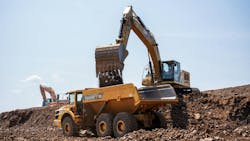Key Highlights
In this article, you will learn:
- What a data analyst does.
- Key data-driven equipment metrics.
- How data benefits maintenance management.
- How to manage expectations when implementing change.
In one of her early meetings as telematics data analyst for William A. Hazel, Inc., 26-year-old Sam Williams (Mosher) kept saying, “When we put gas in the machine.”
“No gas will ever go in the equipment,” she was told. “You have to stop saying that.”
So began the acclimation of an analyst who had been monitoring truck data for an Amazon logistics supplier and was now charged with building a system optimizing machine data in a mixed fleet of construction equipment.
More asset management
- Ensure data integrity in fleet management.
- Extend the sweet spot on machine life.
- Attack the causes of equipment cost.
- How to choose the right equipment rate methodology.
Williams, having freshly decided to pursue a career in logistics rather than continue teacher training, had worked five years for Robertson Logistics, a last-mile service provider for Amazon. She landed on the operations side of the business, helping to ensure that truck data were accurate. Williams is also a member of the 2025 Class of Under 40 in Construction Equipment.
“In the Amazon world, that is No. 1 key, because that’s how they get paid,” she says. “I really liked being in this really niche position and just trying to bring tech into that world.”
What does a data analyst do?
William A. Hazel, Inc., hired Williams to bring tech into its world of construction. Hazel is a site-development and road-building contractor based in Northern Virginia with a mixed fleet numbering several hundred machines.
Williams is the company’s telematics data analyst and dispatch manager. Her data expertise feeds the company’s rate structure and maintenance management, and her dispatching duties keep her attuned to what is happening in the field. She reports to the company’s chief operating officer.
The company was using a fleet-management system when Williams was hired, she says, but they had only just begun work on aggregating the data.
“We probably had 200 or so pieces that we weren’t getting data on yet,” she says. “We had to figure out what kind of data [we wanted] and make sure all of those [machines] were hooked up and make sure all the APIs were running.
“I came on board, and I started working with Cat and John Deere and all of our OEM providers, making sure our API systems were hooked up, making sure we were putting boxes on the pieces that didn’t come with [them],” Williams says. “And then, once we started getting accurate data, I started putting reports together.”
Williams says key data points are utilization, idling, and availability rate, which rely on accurate engine hours.
“At the end of the day, every single hour across hundreds of pieces of equipment really changes our bottom [line],” she says. “Having that data and making sure that we are using all of this for our year-to-year operations is really important.”
Clue Insights provides the data-management platform, which aggregates the various APIs and machine feeds. “Instead of having to try to mash six different systems into one report, it can pull everything, put it exactly where we need it, and put it all in one spot for us to manage,” Williams says.
In one example, a wheel loader was displaying 0 idle hours over a period of two months. “I know that’s not true,” she says. “At that point I would go to our Cat system, VisionLink, and check their hard data. Whatever is in VisionLink is going to be in Clue. It’s going to reflect whatever Cat is seeing. So essentially, I would need to then go to Cat and say, ‘Hey, these aren’t working. We’re not getting any data off of them.’”
How data ensures maintenance efficiency
Williams also is responsible for setting up new equipment within the data-management system, assigning it a preventive maintenance plan. When the machine is nearing a scheduled PM, the system notifies the maintenance manager, who then assigns the work order. She also trains the technicians on how to use the system.
“We have a shop at our office, and then we also have several field mechanics,” Williams says. “I make sure they know how to work [the system], make sure they know how to go in and do their work orders. If something’s not working with their work orders, I would then be responsible for going and fixing that problem.”
How to earn trust during data implementation
Her biggest challenge was coming into an industry that did not have much technology, she says. Earning trust took time, and accurate data was the first step in building that trust. Processes that replaced paper with a smartphone had to work right all the time, she says, “so that they could get their job done.”
“Finally, after three years and really having a good program, they’ve definitely seen the benefits of using the program,” she says. “I think it started to make their days a lot easier without having to worry about all the extra paperwork.”
Williams also credits her duties as dispatcher for helping in the transition.
“I’m in constant contact with the field all day long,” she says. “I probably receive and call people a hundred times a day. I think [that] has really helped our relationship as far as presenting them with a program and really just being patient with them.
“They can trust me as their dispatcher, so that really helps them to trust me to be able to go in and use this program.”
Her experience with Robertson’s truck data system prepared her to skillfully manage the transition with equipment operators, she says.
“I was there when we did this process with Amazon," says Williams. “I had been in a management position— ‘We're going to be tracking you through GPS; we’re going to be watching you on cameras’—and how to really get a lot of driver buy-in. I already knew what the challenges were going to be and how to show the drivers why we’re doing this and how it’s going to benefit them.”
Three years ago, Williams didn’t know the difference between an excavator and a skid steer. Now her data enable the COO and CFO to set accurate equipment rates.
“This size excavator ran an average of 40 hours per week,” she says. “So based off of that, what do we need to get our internal rate or external rate to be to make sure that we’re paying for that, including insurance and everything else?
“When I started, I had a love and a passion for bringing technology into a field that’s not predominant yet and being able to make our day-to-day operations a lot easier and being able to rely on real data," she says.
Her passion is paying off for William A. Hazel.
About the Author
Rod Sutton
Sutton has served as the editorial lead of Construction Equipment magazine and ConstructionEquipment.com since 2001.
Our mission is to help managers of heavy equipment and trucks to improve their performance in acquiring and managing their fleets. One way we do that is with our Executive Institute, where experts share information and ideas that will enable equipment managers to accurately manage equipment costs so that they can deliver the optimum financial benefits to their organizations.
We also have a laser focus on product development, performance, and technology; as well as equipment acquisition, disposal, and maintenance. Our exclusive Field Tests take earthmoving equipment and truck into the field for professional evaluations.
Check out our free newsletters to see the latest content.
You can find Sutton on LinkedIn.




